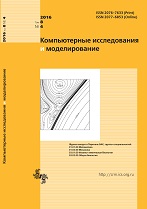|
MODELS IN PHYSICS AND TECHNOLOGY
Electric field effects in chemical patterns
P. Dähmlowa, Ch. Luengviriab, S. C. Müllera
a Institute of Experimental Physics, University Magdeburg, Universitätsplatz 2, D-39106 Magdeburg, Germany
b Department of Physics, Kasetsart University, 50 Phaholyothin Road, Jatujak, Bangkok 10900, Thailand
Abstract:
Excitation waves are a prototype of self-organized dynamic patterns in non-equilibrium systems. They develop their own intrinsic dynamics resulting in travelling waves of various forms and shapes. Prominent examples are rotating spirals and scroll waves. It is an interesting and challenging task to find ways to control their behavior by applying external signals, upon which these propagating waves react. We apply external electric fields to such waves in the excitable Belousov-Zhabotinsky (BZ) reaction. Remarkable effects include the change of wave speed, reversal of propagation direction, annihilation of counter-rotating spiral waves and reorientation of scroll wave filaments. These effects can be explained in numerical simulations, where the negatively charged inhibitor bromide plays an essential role. Electric field effects have also been investigated in biological excitable media such as the social amoebae Dictyostelium discoideum. Quite recently we have started to investigate electric field effect in the BZ reaction dissolved in an Aerosol OT water-in-oil microemulsion. A drift of complex patterns can be observed, and also the viscosity and electric conductivity change. We discuss the assumption that this system can act as a model for long range communication between neurons.
Keywords:
autowaves, chemical patterns, electric field effects.
Received: 06.06.2014
Citation:
P. Dähmlow, Ch. Luengviria, S. C. Müller, “Electric field effects in chemical patterns”, Computer Research and Modeling, 6:5 (2014), 705–718
Linking options:
https://www.mathnet.ru/eng/crm354 https://www.mathnet.ru/eng/crm/v6/i5/p705
|

|




 Contact us:
Contact us: Terms of Use
Terms of Use
 Registration to the website
Registration to the website Logotypes
Logotypes








 Citation in format
Citation in format 